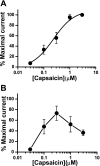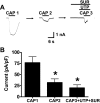P2Y2 receptors mediate ATP-induced resensitization of TRPV1 expressed by kidney projecting sensory neurons
- PMID: 20335377
- PMCID: PMC2886708
- DOI: 10.1152/ajpregu.00235.2009
P2Y2 receptors mediate ATP-induced resensitization of TRPV1 expressed by kidney projecting sensory neurons
Abstract
The transient receptor potential vanilloid type 1 (TRPV1) channel is a ligand-gated cation channel expressed by sensory nerves. P2Y receptors are G protein-coupled receptors that are also expressed by TRPV1-positive sensory neurons. Therefore, we studied interactions between P2Y receptors and TRPV1 function on kidney projecting sensory neurons. Application of Fast Blue (FB) to nerves surrounding the renal artery retrogradely labeled neurons in dorsal root ganglia of rats. Whole cell recording was performed on FB-labeled neurons maintained in primary culture. Capsaicin was used to activate TRPV1. Four types of kidney projecting neurons were identified based on capsaicin responses: 1) desensitizing (35%), 2) nondesensitizing (29%), 3) silent (3%), and 4) insensitive (30%). Silent neurons responded to capsaicin only after ATP (100 microM) pretreatment. ATP reversed desensitization in desensitizing neurons. Insensitive neurons never responded to capsaicin. UTP, a P2Y purinoceptor 2 (P2Y(2))/P2Y(4) receptor agonist, reversed capsaicin-induced TRPV1 desensitization. 2-methyl-thio-ATP (2-Me-S-ATP), a P2Y(1) receptor agonist, did not change desensitization. MRS 2179 and pyridoxal-phosphate-6-azophenyl-2',4'-disulfonic acid (PPADS), drugs that block P2Y(1) receptors, did not block ATP-induced resensitization of TRPV1. Suramin, a P2Y(2) receptor antagonist, blocked resensitization caused by UTP. Immunocytochemical studies showed that FB-labeled neurons coexpressed P2Y(2) receptors and TRPV1. We conclude that P2Y(2) receptor activation can maintain TRPV1 function perhaps during sustained episodes of activity of kidney projecting sensory neurons.
Figures









Similar articles
-
Co-activation of P2Y2 receptor and TRPV channel by ATP: implications for ATP induced pain.Cell Mol Neurobiol. 2005 Aug;25(5):819-32. doi: 10.1007/s10571-005-4936-8. Cell Mol Neurobiol. 2005. PMID: 16133936 Free PMC article.
-
Possible involvement of P2Y2 metabotropic receptors in ATP-induced transient receptor potential vanilloid receptor 1-mediated thermal hypersensitivity.J Neurosci. 2003 Jul 9;23(14):6058-62. doi: 10.1523/JNEUROSCI.23-14-06058.2003. J Neurosci. 2003. PMID: 12853424 Free PMC article.
-
A novel P2-purinoceptor expressed by a subpopulation of astrocytes from the dorsal spinal cord of the rat.Br J Pharmacol. 1995 Dec;116(7):2909-18. doi: 10.1111/j.1476-5381.1995.tb15944.x. Br J Pharmacol. 1995. PMID: 8680724 Free PMC article.
-
Regulation of renal NaCl and water transport by the ATP/UTP/P2Y2 receptor system.Am J Physiol Renal Physiol. 2011 Sep;301(3):F463-75. doi: 10.1152/ajprenal.00236.2011. Epub 2011 Jun 29. Am J Physiol Renal Physiol. 2011. PMID: 21715471 Free PMC article. Review.
-
Capsaicin, The Vanilloid Receptor TRPV1 Agonist in Neuroprotection: Mechanisms Involved and Significance.Neurochem Res. 2023 Nov;48(11):3296-3315. doi: 10.1007/s11064-023-03983-z. Epub 2023 Jul 26. Neurochem Res. 2023. PMID: 37493882 Free PMC article. Review.
Cited by
-
Activation of TRPV1-Expressing Renal Sensory Nerves of Rats with N-Oleoyldopamine Attenuates High-Fat-Diet-Induced Impairment of Renal Function.Int J Mol Sci. 2023 Mar 25;24(7):6207. doi: 10.3390/ijms24076207. Int J Mol Sci. 2023. PMID: 37047183 Free PMC article.
-
P2Y receptors in the mammalian nervous system: pharmacology, ligands and therapeutic potential.CNS Neurol Disord Drug Targets. 2012 Sep;11(6):722-38. doi: 10.2174/187152712803581047. CNS Neurol Disord Drug Targets. 2012. PMID: 22963441 Free PMC article. Review.
-
P2Y receptors and kidney function.Wiley Interdiscip Rev Membr Transp Signal. 2012;1(6):731-742. doi: 10.1002/wmts.61. Epub 2012 Aug 9. Wiley Interdiscip Rev Membr Transp Signal. 2012. PMID: 23145369 Free PMC article.
-
Deletion of the Transient Receptor Potential Vanilloid 1 Channel Attenuates Sympathoexcitation and Hypertension and Improves Glomerular Filtration Rate in 2-Kidney-1-Clip Rats.Hypertension. 2023 Aug;80(8):1671-1682. doi: 10.1161/HYPERTENSIONAHA.123.21153. Epub 2023 Jun 19. Hypertension. 2023. PMID: 37334698 Free PMC article.
-
N-octanoyl-dopamine is an agonist at the capsaicin receptor TRPV1 and mitigates ischemia-induced [corrected] acute kidney injury in rat.PLoS One. 2012;7(8):e43525. doi: 10.1371/journal.pone.0043525. Epub 2012 Aug 20. PLoS One. 2012. PMID: 22916273 Free PMC article.
References
-
- Arulmani U, Heiligers JP, Garrelds IM, Sanchez-Lopez A, Willems EW, Villalon CM, Saxena PR. Effects of sumatriptan on capsaicin-induced carotid haemodynamic changes and CGRP release in anaesthetized pigs. Cephalalgia 24: 717–727, 2004 - PubMed
-
- Bhave G, Zhu W, Wang H, Brasier DJ, Oxford GS, Gereau RW. cAMP-dependent protein kinase regulates desensitization of the capsaicin receptor (VR1) by direct phosphorylation. Neuron 35: 721–731, 2002 - PubMed
-
- Bossowska A. Distribution of primary afferent neurons associated with the porcine inferior mesenteric ganglion (IMG). Folia Histochem Cytobiol 40: 367–372, 2002 - PubMed
-
- Buck SH, Burks TF. The neuropharmacology of capsaicin: review of some recent observations. Pharmacol Rev 38: 179–226, 1986 - PubMed
-
- Burnstock G. Purines and sensory nerves. Handb Exp Pharmacol 194: 333–392, 2009 - PubMed
Publication types
MeSH terms
Substances
Grants and funding
LinkOut - more resources
Full Text Sources
Miscellaneous

